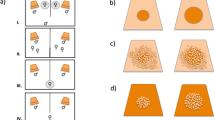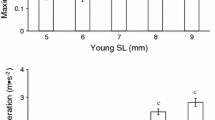Abstract
Numerical abilities have been found to be adaptive in different contexts, including mating, foraging, fighting assessment and antipredator strategies. In species with parental care, another potential advantage is the possibility to adjust parental behavior in relation to the numerosity of the progeny. The finding that many fish vary their parental investment in relation to brood size advocates the existence of a mechanism for appraising offspring number, an aspect that has never been directly investigated. Here we tested the ability of parental female convict cichlid (Amatitlania nigrofasciata) to discriminate between two fry groups differing in number by measuring time spent attempting to recover groups of fry experimentally displaced from the next. Females spent more time trying to recover the fry from larger groups when tested with contrasts 6 versus 12 (1:2) and 6 versus 9 fry (2:3); however, they showed no preference in the 6 versus 8 (3:4) contrast, suggesting that this task exceeds their discrimination capacity.


Similar content being viewed by others

References
Agrillo C, Dadda M, Serena G (2008) Choice of female groups by male mosquitofish (Gambusia holbrooki). Ethology 114:479–488
Agrillo C, Miletto Petrazzini ME, Bisazza A (2014) At the root of math: numerical abilities in fish. In: Geary DC, Berch DB, Koepke KM (eds) Evolutionary origins and early development of basic number processing. Elsevier, Amsterdam, pp 3–27
Alonzo JJ, McKaye KR, van den Berghe E (2001) Parental defense of young by the convict cichlid, Archocentrus nigrofasciatus in Lake Xiloá, Nicaragua. J Aquaric Aquat Sci 9:209–228
Beran MJ, Parrish AE, Evans TA (2014) Numerical cognition and quantitative abilities in nonhuman primates. In: Geary DC, Berch DB, Koepke KM (eds) Evolutionary origins and early development of basic number processing, 1st edn. Elsevier, Amsterdam, pp 91–112
Bockelman AK, Itzkowitz M (2008) Males respond differently than females to mate loss in the biparental convict cichlid fish. Behaviour 145:313–325
Cantlon JF, Brannon EM (2006) Shared system for ordering small and large numbers in monkeys and humans. Psychol Sci 17:401–406
Carazo P, Font E, Forteza-Behrendt E, Desfilis E (2009) Quantity discrimination in Tenebrio molitor: evidence of numerosity discrimination in an invertebrate? Anim Cogn 12:463–470
Clutton-Brock TH (1991) The evolution of parental care. Princeton University Press, New Jersey, p 368
Coleman RM, Gross MR, Sargent RC (1985) Parental investment decision rules: a test in bluegill sunfish. Behav Ecol Sociobiol 18:59–66
Dadda M, Piffer L, Agrillo C, Bisazza A (2009) Spontaneous number representation in mosquitofish. Cognition 112:343–348
Feigenson L, Dehaene S, Spelke E (2004) Core systems of number. Trends Cogn Sci 8:307–314
Garland A, Low J, Burns KC (2012) Large quantity discrimination by North Island robins (Petroica longipes). Anim Cogn 15:1129–1140
Gómez-Laplaza LM, Gerlai R (2013) Quantification abilities in angelfish (Pterophyllum scalare): the influence of continuous variables. Anim Cogn 16:373–383
Hager MC, Helfman GS (1991) Safety in numbers: shoal size choice by minnows under predatory threat. Behav Ecol Sociobiol 29:271–276
Hert E (1991) Female choice based on egg-spots in Pseudotropheus aurora Burgess 1976, a rock-dwelling cichlid of Lake Malaŵi, Africa. J Fish Biol 38:951–953
Itzkowitz M, Santangelo N, Cleveland A, Bockelman A, Richter M (2005) Is the selection of sex-typical parental roles based on an assessment process? A test in the monogamous convict cichlid fish. Anim Behav 69:95–105
Krebs JR (1978) Optimal foraging: decision rules for predators. In: Krebs JR and Davies NB (eds) ‘Behavioural ecology: an evolutionary approach’. Sinauer Associates, Sunderland, MA, pp 23–63
Latifi T, Forsatkar MN, Nematollahi MA (2015) Reproduction and behavioral responses of convict cichlid, Amatitlania nigrofasciata to fluoxetine. J Fish Aquat Sci 10:111–120
Lavery RJ, Reebs SG (1994) Effect of mate removal on current and subsequent parental care in the convict cichlid (Pisces: cichlidae). Ethology 97:265–277
Lucon-Xiccato T, Petrazzini MEM, Agrillo C, Bisazza A (2015) Guppies discriminate between two quantities of food items but prioritize item size over total amount. Anim Behav 107:183–191
Lyon BE (2003) Egg recognition and counting reduce costs of avian conspecific brood parasitism. Nature 422:495–499
McComb K, Packer C, Pusey A (1994) Roaring and numerical assessment in contests between groups of female lions, Panthera leo. Anim Behav 47:379–387
Pahl M, Si A, Zhang S (2013) Numerical cognition in bees and other insects. Front Psychol 4:162. doi:10.3389/fpsyg.2013.00162
Panteleeva S, Reznikova Z, Vygonyailova O (2013) Quantity judgments in the context of risk/reward decision making in striped field mice: first “count”, then hunt. Front Psychol 4:53. doi:10.3389/fpsyg.2013.00053
Pritchard VL, Lawrence J, Butlin RK, Krause J (2001) Shoal choice in zebrafish, Danio rerio: the influence of shoal size and activity. Anim Behav 62:1085–1088
Pyke GH, Pulliam HR, Charnov EL (1977) Optimal foraging: a selective review of theory and tests. Quarterly Rev Biol 52:137–154
Rugani R, Regolin L, Vallortigara G (2010) Imprinted numbers: newborn chicks’ sensitivity to number versus continuous extent of objects they have been reared with. Dev Sci 13:790–797
Sargent RC (1988) Paternal care and egg survival both increase with clutch size in the fathead minnow, Pimephales promelas. Behav Ecol Sociobiol 23:33–37
Townshend TJ, Wootton RJ (1985) Adjusting parental investment to changing environmental conditions: the effect of food ration on parental behaviour of the convict cichlid, Cichlasoma nigrofasciatum. Anim Behav 33:494–501
Uller C, Jaeger R, Guidry G, Martin C (2003) Salamanders (Plethodon cinereus) go for more: rudiments of number in an amphibian. Anim Cogn 6:105–112
Ward C, Smuts BB (2007) Quantity-based judgments in the domestic dog (Canis lupus familiaris). Anim Cogn 10:71–80
White DJ, Ho L, Freed-Brown G (2009) Counting chicks before they hatch female cowbirds can time readiness of a host nest for parasitism. Psychol Sci 20:1140–1145
Wilson ML, Hauser MD, Wrangham RW (2001) Does participation in intergroup conflict depend on numerical assessment, range location, or rank for wild chimpanzees? Anim Behav 61:1203–1216
Wisenden BD, Lanfranconi-Izawa TL, Keenleyside MH (1995) Fin digging and leaf lifting by the convict cichlid, Cichlasoma nigrofasciatum: examples of parental food provisioning. Anim Behav 49:623–631
Acknowledgments
The authors gratefully acknowledge Maryam Hedayati rad for her assistance in data collection and behavioral measurements. We are also grateful to Tyrone Lucon Xiccato for his helpful comments on the manuscript. We thank the editor and two anonymous reviewers for their constructive and insightful comments.
Author information
Authors and Affiliations
Corresponding author
Ethics declarations
Conflict of interest
The authors declare that they have no conflict of interest.
Electronic supplementary material
Below is the link to the electronic supplementary material.
Rights and permissions
About this article
Cite this article
Forsatkar, M.N., Nematollahi, M.A. & Bisazza, A. Quantity discrimination in parental fish: female convict cichlid discriminate fry shoals of different sizes. Anim Cogn 19, 959–964 (2016). https://doi.org/10.1007/s10071-016-0997-y
Received:
Revised:
Accepted:
Published:
Issue Date:
DOI: https://doi.org/10.1007/s10071-016-0997-y



